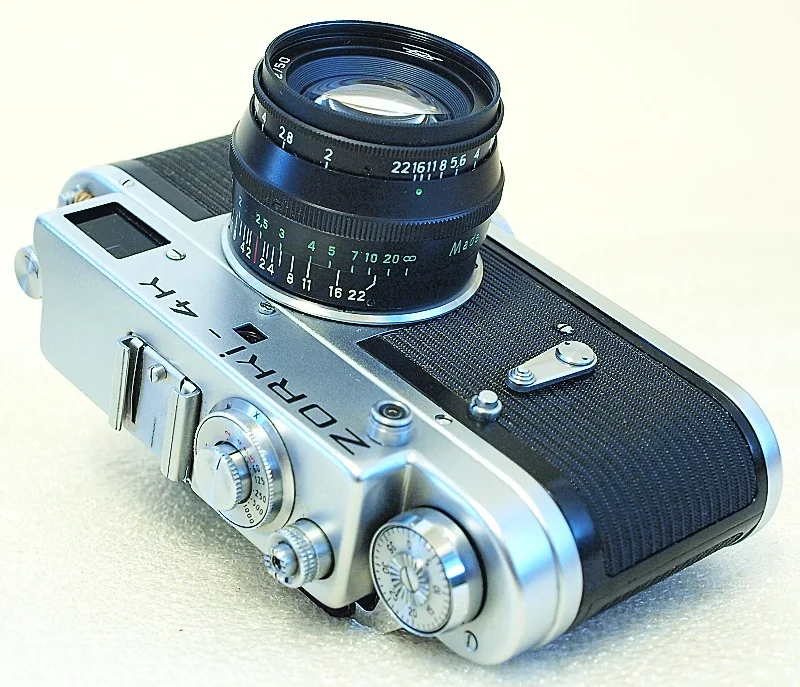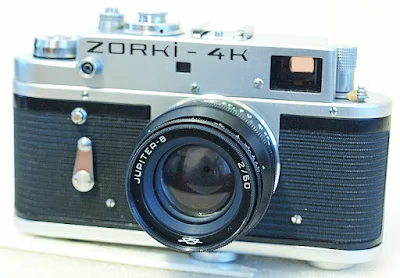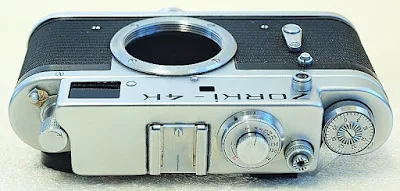The Zorki-4K, a very desirable and worth-the-keep fully manual 35mm rangefinder film camera, was the final model of the Zorki-4 series of film cameras produced by the KMZ factory in Krasnogorsk, Russia. The Zorki-4 rangefinder series, based on the design of the German Leica L39 was first introduced in 1956. The series was the most popular of all Zorki camera series.
As compared to the original Zorki-4 which uses a thumbwheel to advance to film and cock the shutter, the Zorki-4K, produced between the years 1972 to 1978, comes fitted with a fixed take-up spool and a film wind lever for easier operation. The camera operates with a shutter speed range from 1 second to 1/1000 second, and B. Flash sync speed setting is recommended at 1/30 second. The camera is also fitted with a mechanical 9-second delay self-timer.
Being fully manual, the camera does not have a light meter, and it does not need a battery to run. The camera does not come with a film ISO speed dial either. As a kit set, the Zorki-4K was normally fitted with a Jupiter 8 50mm F2 as the standard lens. The Jupiter 8, for your information, is another post-war Russian product that comes with its own acclaim.
Zorki 4K - the best Russian Rangefinder?
The Zorki 4K is making more and more sense as a film rangefinder camera - here's my review
A feature worth noting about the Zorki's is a very capable diopter correction system operated by a lever located at the base of the film rewind knob and works better than those seen implemented on some other models of rangefinder cameras.
Basic Camera Features
An operational procedure that cannot be stressed often enough with the Zorki-4 series cameras is the routine used to change the shutter speed setting. As with other Soviet-era rangefinders, the shutter speed selector rotates when the shutter is released, and should not be changed until after the shutter has been cocked.
Note: If the shutter speed is changed without cocking the shutter first, the setting pin can be broken when the film is advanced.
Coming with a rather minimalist built form, with a profile that reminisces the broadside of a merchant ship, the front plane of the camera body has only the screw-thread lens mount, with the self-timer lever and its release button located vertically to the left, and on the broadside of the deck, the flash sync socket, a small rangefinder window, and the viewfinder window itself.
On the top plane, from left to right is the pull-up film rewind knob with the diopter correction lever located at its base, a flash shoe located axially above the lens mount, and to the right, the shutter speed dial which is integrated with the concentric flash sync scale, the shutter release button integrated with the finger guard shutter release lock, which also functions as the film rewind release.
On the far right of the top plane is the film forward lever which is integrated with the manual set film frame counter. The index mark for the counter is located at the back of the dial crown.
On the backplane of the camera, just the viewfinder eyepiece and the film forward lever thumb rest. The rest of the camera back is part of the clamshell film which is completely unlatched and removed from the camera body for loading and unloading film.
For the clamshell film back, the bottom plane is only populated by the tripod socket a pair of half-turn release locks, with the lock on the right turned anticlockwise to release, and the lock on the left turned clockwise. Once the locks are released push them back out with your thumb and the whole back will slide out easily.
The film box is a standard configuration as seen on most other cameras with clamshell backs. The film canister chamber is located on the left end of the camera body, with the shutter window, sprocket gear, and a multislot takeup spool lined up to the right.
Film Loading and Rewind
For the uninitiated, film-loading cameras with clamshell film backs may seem intimidating initially, but no worries, it is just as you would it with a normally hinged back film camera. Place the new film canister in the leftmost chamber, pull the film tab across the whole film box, and insert the tab end into one of the multi-slots of the take-up spool on the inner side of the camera body. The spool rotates in the opposite direction of the film wind lever and is spooled with the emulsion side up.
Ensure that the perforations on the film edge are properly engaged with the sprocket gear, and give the film forward lever a half turn to ensure that the film is properly tensioned before closing the back. Next, do the mandatory 2-blank shots to advance the unexposed part of the film to Frame 1. Then, reset the film frame counter back to 0 and you are ready to go.
To rewind and unload, the first step is to enable film rewind by turning the shutter finger guard all the way clockwise (this is equivalent to pressing the rewind release button on later film cameras). Next, extend (pull up) the film rewind knob out and rotate in the direction of the pointed arrow (clockwise) until the film is completely wound back into the film canister. Unlock and open the film back to remove the exposed film roll safely.
Viewfinder Readout
The viewfinder of the Zorki-4K is a simple bright frame with 1.15 magnification, with a small rectangular parallax window located centrally with the frame line. Diopter correction, I believe, has to be adjusted for differing focus distances, after which the parallax correction will be very much easier to use and adjust.
The rangefinder mechanism is coupled to the lens by way of a small tab located internally at the top of the lens mount opening. The tab moves back and forth with the focusing movement of the lens and this is equated to the parallax movement of the rangefinder.
Using the Self-Timer
The self-timer is a simple mechanical setup. To activate, forward the film frame, rotate the timer lever in the anticlockwise distance past the 90d location, or all the way it will go. Press the self-timer release button, located above the lever location, to actuate.
Jupiter-8 50mm F2
Worthwhile to mention on its own is the Jupiter-8 (in Cyrillic, ЮПИТЕР-8), a 6-elements in 3-groups 50 mm F2 lens which is fitted as a standard lens to later models of the Zorki-4K (on earlier models, the 4K is fitted with an Industar-50 50mm f/3.5 lens). The lens, a close copy of the Zeiss Sonnar, was also made by KMZ.
The Jupiter-8 was originally made with a polished aluminum barrel, though some examples exist in stainless steel. From the 1970s, the lens was made in a black finish (the barrel is still aluminum). The lens has an aperture range from f/2 to f/22, takes 40.5mm filters, and has step-less aperture stops.
Camera Body Weight
The bodyweight of the Zorki-4K mounted with the standard Jupiter 8 50mm F2 is approximately 700 grams.
Sunny 16 Rule
The way to meter for correct exposure during daylight for a fully manual camera, one that is not fitted with a light meter, is to go by way of the Sunny 16 Rule.
The Sunny 16 is a basic rule of thumb that says, if you have a clear, sunny day and your aperture is at f/16, whatever ISO you are using, your shutter speed will be the reciprocal value of that ISO value (ISO X = 1/X seconds shutter speed).
Learn more about the rule from the source here: Photography Essentials: The Sunny 16 Rule
Instruction Manual
The full instruction manual (in English) for the Zorki-4K can be downloaded thanks to cameramanuals.org
A Finder's Keeper
The Zorki-4K, with its reputation of a robust build and the most reliable among the Zorki models, is an easy and fun camera to use, and together with the Jupiter 8, a budget-priced Sonnar which in a way is becoming a 'must-have' among photo enthusiasts, the camera kit is definitely a finder's keeper.
On a good working copy, you should be able to find a camera that performs flawlessly with a very smooth film advance and very crisp shutter actuation, and a Jupiter-8 that excels itself with a very smooth focus and aperture ring movement. Though these may not be the ultimate if you are looking for precision engineering or lens sharpness, the Zorki-4K and Jupiter-8 kit is still a worthy classic and an icon of its time.























No comments:
Post a Comment